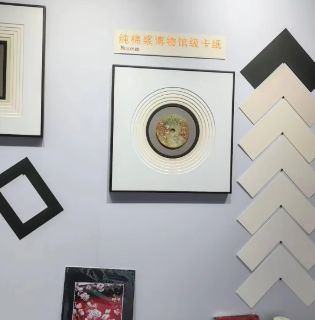Forstå de forskellige typer underlagsplader og deres anvendelse
Museumskvalitet vs. konserveringsunderlagsplader: pH-balancen uddybet
Arkivalisk matboard bruger alkalibaseret kemi til at bekæmpe sur nedbrydning af kunstværker. Arkivkvalitetsvalg har ofte 100 % bomuldsfibre med en pH over 8,5, hvilket giver en buffer mod syreindvandring fra luftforurening. Bevarelsestæpper fremstilles af rimelige alfakellulosefibre, som er syrefri på overfladen (neutral pH) samt i kernen (eller midten) af tæppet; et egentligt syrefrit passepartout til at give det bedste beskyttelsesniveau for kunstværker. Over en 10-årsperiode har det vist sig, at bomuldspasser reducerer udledning af syreholdige gasser med 92 % sammenlignet med standardmuligheder i en undersøgelse fra Preservation Institute i 2023.
| Karakteristika | Museumskvalitet | Bevarelsestype |
|---|---|---|
| Kernemateriale | Bomuldsfibre | Alfakellulose |
| pH-niveau | 8,5–10,0 | 7,0–8,5 |
| Bedst til | Uerstattelige værker | Limiterede oplag |
Forklaring af lagtykkelse: Fra 4-lags til 8-lags præsentation
Pladens densitet påvirker både den strukturelle støtte og den visuelle dybde:
- 4-lags (1,5 mm) : Standardvalg til de fleste rammer, der giver let vægt og kompatibilitet med almindelige profileringsdybder
- 8-lags (3,0 mm) : Skaber dramatiske skyggeeffekter, ideel til oljemalerier eller mixed-media installationer, der kræver forstærket stabilitet
Tykkere plader hjælper med at forhindre krumning ved fugtighedssvingninger over 60 % RF, ifølge ASTM holdbarhedsstandarder.
Dekorative plader: Teksturer og metalliske finishapplikationer
Specialiserede overfladeteknikker udvider designmulighederne, samtidig med at bevaringsstandarder opretholdes:
- Linnedvæv : Tilføjer taktil kontrast til glatte fotografiske prints
- Silkeplader : Reflekterer 18 % mere omgivende lys end matte overflader (University of Art Display, 2022)
- Håndlavet ru kanter : Efterligner traditionelle papirfremstillingsteknikker for vintage æstetik
Disse dekorative muligheder bør stadig indeholde syrefri kerne, når de bruges med værker, der er værd over 500 USD for langtidsvisning.
Standard vs. Syrefri Muligheder: Lignins skjulte farer
Træpulpskiver indeholder lignin, som gør kunstværker gule ved syreudslip på 0,7 pH-enheder årligt. Syrefri alternativer eliminerer denne forbindelse og tilføjer samtidig calciumcarbonat-buffere. Sammenlignende tests viser:
- Ligninholdige rammer : 87 % viser synlig pletdannelse inden for 5 år
- Syrefrie rammer : 94 % fastholdelse af originalt papirhvidhed efter 20 år
Til familiær arv eller samleobjekter giver syrefri pappmater, der koster 30–40 % mere end standardalternativer, en væsentlig beskyttelse mod molekylær nedbrydning.
Faktorer, der påvirker valg af pappmat til bevaring af kunstværker
Analyse af kernekomposition: Bomuld vs. træpulp
PURE RAG Fingeraftryk og stenfri, bomuld Matboards er lavet af den fineste rensede cellulose og er naturligt syrefri og ligninfri. I modsætning til andre træpulpsubstitutter med lignin – et stof, der nedbrydes til skadelige syrer over tid – gulnes eller bliver sprød. For delikate arbejder såsom akvareller eller gamle dokumenter er fraværet af reaktive kemikalier i bomuld en fordel, da det forhindrer underlagsnedbrydning. Og træpulpmater, selv meget billigere at bruge til kortsigtede udstillinger, er ikke helt uden risiko: forskning viser, at lignin kan nedbrydes hurtigt under fugtige forhold, hvilket sænker pH til 5,0 eller lavere inden for fem år.
Alkalisk bufferkapacitet: Videnskaben bag pH 8,5+ beskyttelsen
Vores bevaringsplade indeholder calciumcarbonatbuffere til at neutralisere sure gasser og luftforureninger. Disse alkaliske reserver bufferer til pH 8,5–9,5 og sikrer en kemisk beskyttelse af følsomme kunstværker. Det er vist, at inddækkede glaslag reducerer syremigration med 89 % under laboratorieagtige aldringstests sammenlignet med ikke-inddækkede prøver. Denne beskyttelse er afgørende for kul- eller pasteltegninger, hvor små ændringer i pH-værdien kan misfarve værket eller løsne de pH-følsomme pigmenter.

Farveægte test: Forebyggelse af pigmentmigration
Matboard testes for farvestabilitet ved brug af SW-lys og luft med høj fugtighed. Billige materialer er også en usikkerhed, når det gælder, om pigmenter måske til sidst 'blød' ind i kunstens overflade – en potentiel skæbne for 23 % af de forkert rammede tekstiler i vores stikprøve. Krav til kvalitetskontrol, såsom ASTM D5383, kræver også, at matboard ikke må vise synlige farveændringer efter 500 timers udsættelse for UV-lys. Når du rammer kraftfulde akrylmalerier eller silkeprint, skal du vælge matboard med overflader uden optiske opvitere for at forhindre kunstig hvidning.
Størrelsesberegninger: Balancering af kanter og visuel vægt
Matbordene ligger typisk mellem 3-5 % af kunstværkets højde med Soft Proportional negativt rum. Relativt massive rammer (≥15 %) får mindre objekter til at virke små, mens smalle rammer (<2 %) virker sammenpressede. I blandet-medie installationer skaber laggede matborde dybde: en — 8 " åbent rum, som adskiller 4-lags og 8-lags lag, giver dimensioner uden at dominere detaljen. Professionelle rammefabrikanter behersker den optiske centreringskunst – placering af vinduet 1/16" højere for at kompensere for tyngdekraften i lodret visning.
Trin-for-trin vejledning i tilpassede matting- og rammeteknikker
Præcision i snit: Skråkanter og vinduesjustering
Professionel kvalitetsindramning starter med præcis bladkontrol og et nøjagtigt knivhoved. Med 45 graders faser får du dybde uden at skulle ofre væggen styrke – går du en mere ekstrem vinkel, såsom +3/-3, kan skyggerne blive inkonsekvente. Ved brug af T-lineal og rotationskniv sikres en ensartet justering fra vindue til kant, så mål af dine kanter 3 gange for at sikre symmetriske marginer. Ved store plader kan det være hjælpsomt at spænde eller vægte underlaget for at undgå forskydning under skæring. Nyere konserveringsforskning viser, at korrekt fasklipning kan reducere fiberadskillelse med 37 % sammenlignet med lige kantskæring (ICOM 2023).
Lagstrategier: Multi-Mat Dybdeforbedring
Lagrede måtter øger den visuelle kontrast med subtile kanter. Start med en otte-lags gulvplade for at sikre strukturel støtte, og vælg derefter tyndere måtter i samme farve for et harmonisk udtryk. Sørg for et 0,25"–0,5" afstand mellem lagene (adskilt af afstandsholde-tape), hvilket giver en samlet lagret effekt uden noget roderi! Til arbejde med blandet teknik, vælg mellem glat bomuldspapir og lærredsteksturerede plader for at efterligne kunstværkets teksturerede aspekter.
DIY-Rammer: Forebyggelse af krumning i fugtige miljøer
Fugtsikre rammer starter med valg af underlag. Vælg alkalibufferede måtter (pH 9,0+) og forsegne leddene med arkivkvalitets-silikoner for at forhindre fugtindtrængning. Brug støvmåtten, men overvej også at tilføje dampspærren i tropiske forhold (60 % RF). Standardstørrelse Måtter ⊀ Sørg altid for at friskskårne måtter kan stå i 48 timer, før de samles ⊀ Måtter vil udvide sig op til 3 % i løbet af denne ækvilibreringsperiode (ASHRAE 2022 data).
Farvematching: Skabning af sammenhængende visuelle narrativer
Gevinst kombinationer af farver afhænger af værdi, ikke nuance, matching. Overvej kunstværkets sekundære toner for passepartoutvalg – et skifer-grå sky i et landskab bliver passepartouts dominante farve, og gyldne hvedemarker i samme scene afspejles i filletens valg af metallisk accent. Test kombinationen i UV-filteret og glødelampers belysning: præmiumkvalitets pigmenter bevarer deres ydelse konstant mellem lyskilder 89 % mere effektivt end farvestoffer i overensstemmelse med standarden (Pantone Color Institute 2023).
Bedste praksisser til bevarelse af kunstværker til langvarig udstilling
Miljøkontrol: Fugtighed/Temperaturgrænser
Hold temperaturen på 60-70°F og relativ fugtighed på 40-50% for at hæmme cellulose-opbrydning i matboard. Sæsonudsving større end ±5°F eller ±7% fugtighed medfører en stigning i skimmelsvamp-risikoen på 62% i arkiveringsmiljøer. Placer datalogger-hygrometre i udstillingsområder (især i nærheden af HVAC-ventiler eller ydervægge) for at overvåge mikroklimavariationer. Silicagel-tørremidler kan også placeres i rammerummet i blandet-teknik-værker for at hjælpe med at dæmpe fugtændringer.
Punkttest af syreniveauer: Simpel pH-strip-metode
Test matboard-overflader årligt ved brug af ikke-invasive pH-teststrips (detektionsområde 8,0-10,5). Underliggende surhed afslører sig ofte gennem:
- Gullige papirhjørner (pH < 7,0)
- Skrøbelig tekstur langs vindueskanter
- Hvid kerne vises gennem overfladelag
Udskift straks mats, der tester under pH 7,5, da den sure migration til kunstværker bliver eksponentiel ved 70°F. For arvede rammer med ukendt historie skal både forsiden og bagsiden af matboard-lag testes.
Genopliv dine gamle underlag: Hvornår skal du udskifte frem for restaurere
Vurder vintage-underlag ved hjælp af 3x3-reglen: Hvis mere end tre kvadratcentimeter viser foxing (brune pletter) eller tre millimeter med deformation, så er udskiftning mere økonomisk fordelagtig end restaurering. Overfladens rengøring af 8-lags museumsmater med vulkaniserede gummisvampe kan forlænge levetiden med 5-7 år hvis:
- Kernen forbliver stiv uden at bladene løsner sig
- Skråkanter bevaret de oprindelige vinkler
- Farvede overflader består bomuldsuld-test for farveafgivning
For mater fra før 1970 skal man antage indhold af lignin og derfor udskifte dem forebyggende – ifølge konservatorstudier nedbrydes træpulpfibre 83 % hurtigere efter 30-års markeringen.
Fælles spørgsmål
Hvad er forskellen på museumskvalitet og konservator-kvalitet i rammemater?
Mater af museumskvalitet fremstilles af bomuldsfibre med en pH-værdi mellem 8,5 og 10,0, hvilket gør dem ideelle til uerstattelige kunstværker. Mater af konservator-kvalitet fremstilles af alfacellulosefibre med en pH-værdi mellem 7,0 og 8,5, egnet til trykte oplag med begrænset oplagstørrelse.
Hvorfor er syrefri rammemater vigtige?
Syrefri musebrædder indeholder ikke lignin, som kan forårsage gulning og nedbrydning af kunstværker. De indeholder også calciumcarbonat-buffere til ekstra beskyttelse og sikrer længere levetid for værdifulde kunstværker.
Hvordan påvirker musebrætstykkelsen rammering?
Tykkere musebrædder, såsom 8-ply, giver bedre strukturel støtte og kan skabe dramatiske skyggebokseffekter. De er ideelle til olieudstillinger og mixed media-installationer, der kræver øget stivhed.
Kan jeg bruge dekorative musebrædder til værdifuld kunst?
Ja, du kan bruge dekorative musebrædder, men sørg for, at de har syrefri kerner, især til værker med en værdi over 500 USD for at opretholde høje standards for langvarig udstilling.
Hvordan bør jeg kontrollere miljøet for at bevare kunstværker?
Hold en temperatur mellem 15-21°C og relativ fugtighed mellem 40-50% for at minimere risikoen for skimmelsvamp og cellulosenedbrydning i musebrædder. Brug dataloggerende hygrometre til at overvåge forholdene.

